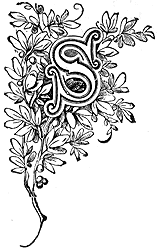 |

T. IVES is situated most picturesquely, - and, from the sea, is itself picturesque. It stands on the west hillside of a large bay; towans, or sand heaps, are scattered on the shore; and the blue waters that dance over the sands in summer, or dash in fury in winter, are bounded only by the horizon. From the high hills to the south we can see both Bristol and its channel. But when we land, the picturesqueness of St. Ives vanishes. The narrow, crooked, dirty streets-the mean old houses-the poor shops-and everywhere the smell of fishrender the town quite unworthy of its beautiful position. It is, in fact, devoted to the pilchard fishery; and from July to October its quay certainly presents a lively picture of fish, fishermen, and fishwives, at which an artist may rejoice.
St. Ives' Church was begun in Henry V.'s reign, and finished in Henry VI.'s. It has a tower 120 feet high, a chancel, nave, and north and south aisles. There is a Norman font in it. The town was incorporated in 1639, with a mayor, four aldermen, and twelve councillors.
There is a pathetic ghost story attached to the St. Ives' sands. It was a year of storms at the close of the last century, and many wrecks were seen on the rock-bound coast, when one evening the St. Ives' people perceived a large ship, close to the fatal rocks. The crew perceived their danger, as well as the townsmen had, and did their best to save themselves.
But all their efforts were vain. The ship parted her anchors, swing round, struck violently on a rock, and her mast went by the board. The waves swept over her; but the brave and kindly fishermen of St. Ives at once went to her assistance, through the driving storm.
They succeeded in getting near the ship, but not alongside, and they called to the sailors to throw them ropes, by the aid of which several escaped, and were hauled into the boat.
But on the deck there stood a lady with an infant in her arms. They begged her to give the child to a strong man, while they tried to pass her to the boat. But she refused, and tightly clasping her babe, she was lowered into the sea, and the fishermen drew her rapidly into the boat. But she had fainted during the transit, and the infant had been washed from her arms and lost. With the lady, and as many of the crew as they had saved, the fishermen returned to the shore. But when the mother recovered, and found that her child was lost, she sank under the blow, and died. She was buried in St. Ives' churchyard. Soon afterwards a spectral form was seen passing from the churchyard wall, and walking towards the Island. Then it appeared to be diligently searching the sands. When nights were tempestuous and dark, the same form was seen, still earnestly searching, but with a lantern in its hand; it is the mother seeking for her child, who might have been saved if she had let the seaman take it. Death cannot quench a mother's love and remorse.
This appearance is called "The Lady with the Lantern." It is always seen moving over the rocks which run into the sea from the eastern side of the point called the Island, and is supposed to predict stormy weather.
May there be a scientific reason for such a wandering light appearing before a storm?
|
 |